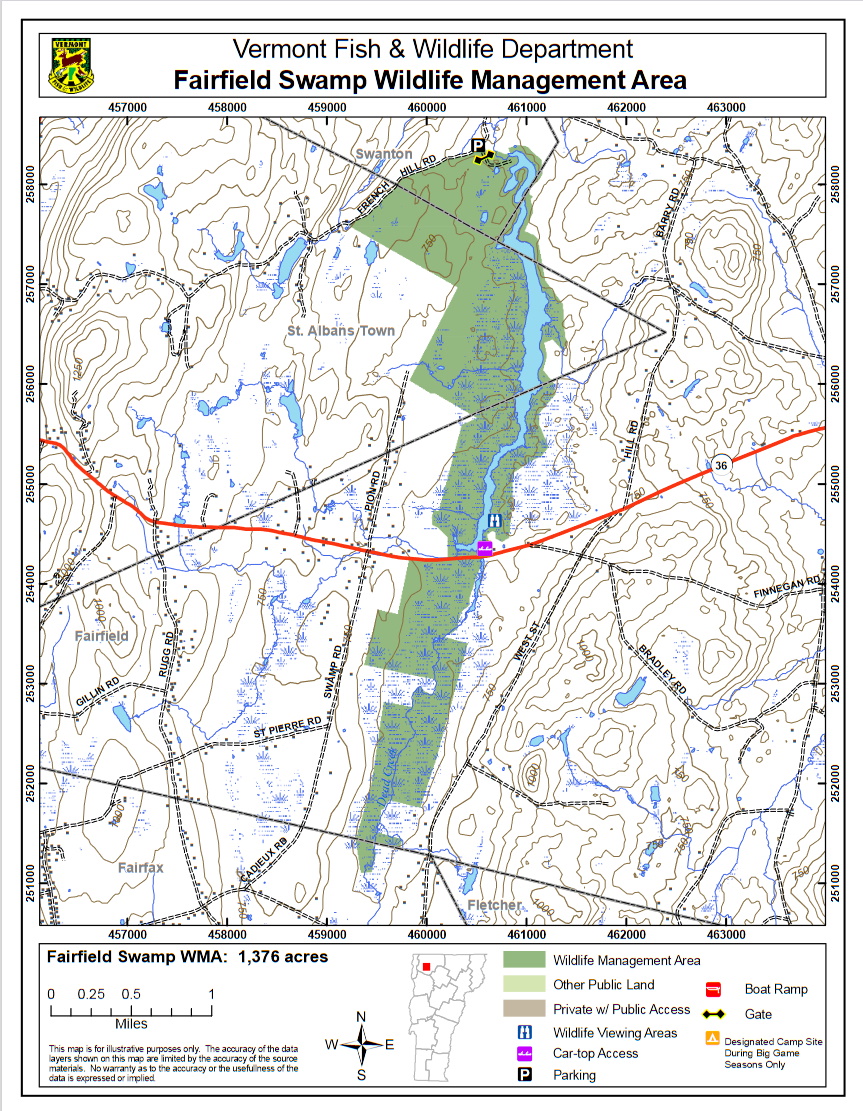Fairfield Swamp WMA
Birds of Interest
There are many species of water birds and waterfowl present in Fairfield Swamp. Great blue and green herons hunt in the shallows. Ospreys, bald eagles, northern harriers, and several other raptor species may be seen overhead. Shorebirds stop by in their bi-annual migrations and spotted sandpipers and common snipe breed in the area. Wood and black ducks, mallards, hooded mergansers, ruffed grouse, and woodcock are common game birds.
There are several species of woodpeckers and flycatchers present, and a complete complement of songbirds. The beautiful Baltimore oriole prefers wetland edges for breeding, and the belted kingfisher digs its nests into soft banks near water.
About Fairfield Swamp Wildlife Management Area
See all hotspots at Fairfield Swamp Wildlife Management Area
Fairfield Swamp Wildlife Management Area (WMA) is a 1,376-acre tract located mostly in the town of Fairfield. It includes a large wetland complex with adjoining upland forests. It is owned by the State of Vermont and managed by the Vermont Fish and Wildlife Department. Dead Creek, which flows north through the WMA, was dammed in the 1960s to create more wetland habitat. The swamp can be accessed from the parking area east of the causeway on VT-36 in Fairfield with a canoe put-in and wildlife viewing area. There is also a woods road for foot traffic near the dam at the northwest end of the WMA.
Fairfield Swamp consists of a part of Dead Creek and its associated wetlands. All of the land is low-lying at an altitude of about 850 feet, There is an adjacent area of upland covered with northern hardwood forest. Within the large wetland complex are open water leads, sedge meadow, black spruce-tamarack bog, shrub bog, and cattail, deep bulrush, and deep broadleaf marsh. There are also shrub and forested swamps, especially alder and red maple-northern white-cedar swamps. There is a fen in an area with very poor drainage. This variety of habitats is ideal for a variety of wildlife, especially water birds and amphibians.
There are several species of rare plants in Fairfield Swamp, especially in the fen. These include the State’s only known example of autumn-willow and the white-fringed orchid. More common, but still relatively rare, are the carnivorous pitcher plant and uncommon rose-pink. Because access to such a swamp is difficult, there are likely more rare species that have not been discovered. Rare birds that nest in the WMA are sora, common moorhen, and least and American bitterns.
Two significant natural communities occurring in Fairfield Swamp are deep bulrush marsh and black spruce-tamarack bog. Bulrushes grow in large mats over standing water up to 6 feet deep. They provide feed and cover for water birds. The black spruce bog is home to the rare bog plants noted above. There is also an extensive alder swamp in the WMA, which provides shelter and nesting habitat for a variety of songbirds.
Features
Restrooms on site
Wheelchair accessible trail
Entrance fee
Content from Fairfield Swamp Wildlife Management Area guide and map
Last updated October 16, 2023
